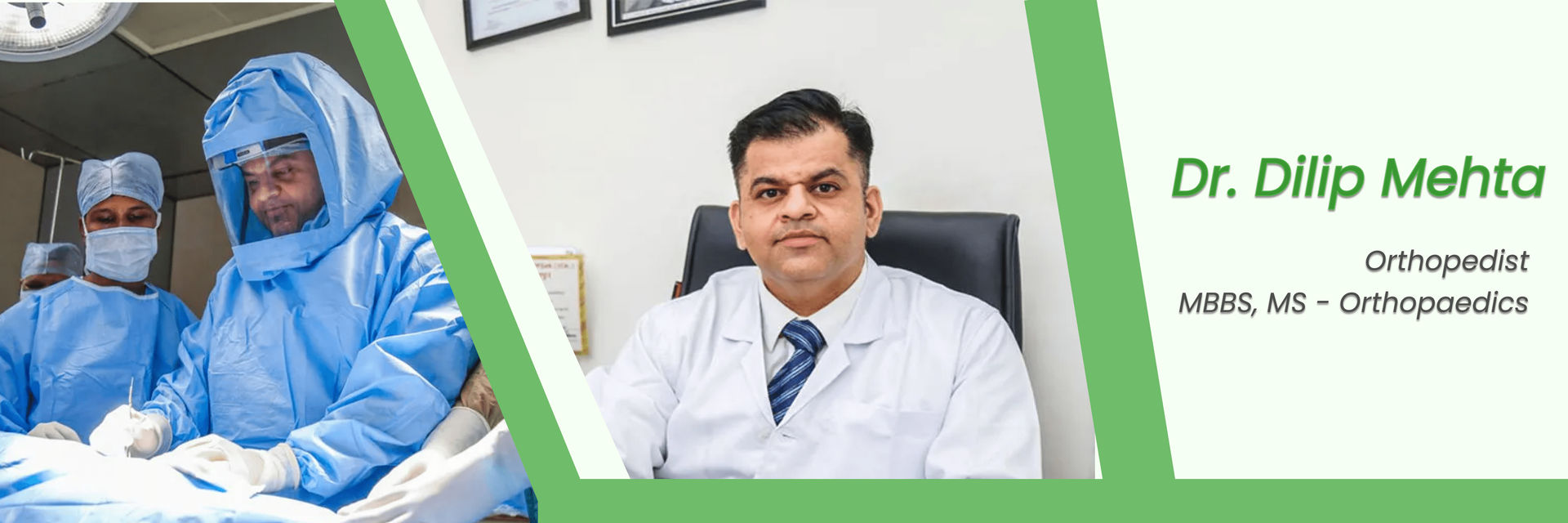Overview
A new surgical procedure called a stemless shoulder replacement is used to treat a variety of shoulder disorders. Such as rotator cuff tear arthropathy, arthritis, and other chronic shoulder diseases. It uses a new type of implant and provides an alternative to regular shoulder surgery. It aims to maintain more of the patient's own bone and match the structure of the shoulder.
You might have known about traditional shoulder replacement, but do you know about stemless shoulder replacement?
Let's have a look at the difference between the both!
Take the first step to recovery. Get in touch with us for your treatment.
Differences: Stemless Shoulder Replacement vs Traditional?
Aspect
| Stemless Shoulder Replacement | Traditional Shoulder Replacement |
| Implant Design | Shorter, without a stem | Longer, with a stem |
| Bone Preservation | Aims to preserve more natural bone | Requires removal of more bone |
| Anatomical Reconstruction | Seeks to replicate natural shoulder anatomy | Deviates from natural anatomy to accommodate the stem |
| Surgical Technique | Typically less invasive | May involve more invasive techniques |
| Incision Size | Smaller incisions | Larger incisions |
| Surgery Time | Potentially shorter | Maybe longer |
| Revision Surgery | Potential advantages for future revisions | Potential challenges due to stem presence |
The acceptability of a stemless shoulder replacement vs a typical shoulder replacement is dependent on a number of variables, including:
- The patient's health
- The quality of the bone
- The skill of the surgeon
- The patient's preferences.
An orthopedic surgeon's advice will help you decide which course of action is best for your specific case.
Discover who can benefit from the amazing advantages of stemless shoulder replacement.
Who is a candidate for stemless shoulder replacement?
Candidature for a stemless shoulder replacement depends on a variety of factors. Candidates for a stemless shoulder replacement, yet, often include:
Patients with degenerative shoulder problems like:
- arthritis
- rotator cuff tear arthropathy
- or other degenerative shoulder condition
may be candidates for a stemless shoulder replacement.
Patients with good rotator cuff tendons:
The rotator cuff tendons' integrity is an important factor to take into account. Patients who have healthy or fixable rotator cuff tendons are often given the recommendation.
Patients with enough bone quality:
The implant needs the right bone quality to be treated. For a stemless implant to work well, the humeral head's density of bones and structure is crucial.
Patients with the correct anatomical alignment:
The shoulder joint's natural alignment is important. A patient is more likely to be a good candidate for stemless shoulder replacement if their shoulder joint is in good shape.
Patients with good shoulder anatomy:
The shoulder anatomy of the patient should be evaluated to see if it is proper for a stemless implant. Important issues are the humeral head's form and the condition of the glenoid (socket).
Patients with fair expectations:
Candidates must be realistic about possible outcomes and limits of the operation. They should be prepared to follow the necessary physical therapy and aftercare rehabilitation guidelines.
You must know the procedure for Stemless shoulder replacement before opting for it!
What is the procedure for stemless shoulder replacement?
Depending on the surgeon's look and the different needs of the patient. The particular stemless shoulder replacement process may change. Here is an overview of the steps needed:
Anesthesia:
The patient is often given general anesthesia, which makes them asleep and pain-free. Regional anesthesia may be used in various cases.
Incision:
To reach the humeral head, the surgeon creates a tiny incision above the shoulder joint.
Preparation for the Humeral Head:
The surgeon cleanses the humeral head by removing any diseased or damaged cartilage and bone.
Implant Position:
The humeral head is inserted with the stemless implant of choice. The joint's natural anatomy is copied, and it is made to fit.
Glenoid Preparation:
In certain cases, the surgeon may also make any required changes or repairs to the glenoid (socket) to fit the implant.
Assessment of Stability and Range of Motion:
To ensure the ideal implant place, the surgeon checks the stability of the joint and checks the range of motion.
Incision Closure:
Sutures or staples are used to close the incision. The wound may get sterile coverings.
Post-operative Care:
As the patient awakens from anesthesia, they are taken to the recovery area and under close watch. Pills to prevent infection as well as painkillers may be given.
Usually, a full rehabilitation program is started after the procedure. Strength, flexibility, and function of the shoulder are improved with physical therapy. Depending on the surgeon's recommendations and the patient's progress, the rehabilitation plan may change.
Now that you know the procedure for stemless shoulder replacement, you must be wondering what is the recovery process after that.
Here’s your answer!
What is the recovery process like after stemless shoulder replacement?
The recovery process involves several stages and is different from patient to patient. Here is a general overview of what to expect:
Hospital Stay:
The patient will usually stay in the hospital for one or two days after surgery. The medical staff will give instructions on post-operative therapy and healing during this period.
Sling and Immobilisation:
To support the arm to promote healing, a sling or a shoulder immobilizer may be given. The surgeon's preference and the specific needs of the patient will determine how long the sling should be used.
Pain control:
Generic painkillers will be given to patients to ease their post-operative discomfort. It's important to keep to the specified doses and inform the medical staff of any unusual or severe pain.
Physical Therapy:
A key aspect of the healing process is physical therapy. The patient will be taken through exercises by a physical therapist with the goal of recovering range of motion and building up the shoulder muscles to improve function. After surgery, therapy often starts a few days to weeks afterward.
Return to Activities:
As time passes, the patient's shoulder will regain its strength, flexibility, and function. The patient's growth and the surgeon's advice will influence when the patient can start normal activities and work. The whole recovery process might take many months.
Follow-up Appointments:
The orthopedic surgeon will arrange many follow-up sessions to assess healing, track progress, and make any required changes.
Return to Activities:
As time passes, the patient's shoulder will regain its strength, flexibility, and function. The patient's growth and the surgeon's advice will influence when the patient can start normal activities and work. The whole recovery process might take many months.
Follow-up Appointments:
The orthopedic surgeon will arrange many follow-up sessions to assess healing, track progress, and make any required changes to the rehabilitation plan.
Every person's recovery is different, and the duration might vary. The surgeon and the patient's rehabilitation team will offer detailed instructions based on their needs and growth.
According to experts at HealthReporter,
“After a stemless shoulder replacement, there are some restrictions on movement and activities. For instance, patients are typically advised not to lift more than 25 pounds after total replacement surgery. However, the benefit of a partial shoulder replacement surgery is that there are no permanent lifting restrictions.”
You don’t need to stress over not knowing the risk and complications of the surgery, we got you covered, here are a few risks mentioned for your better understanding.
Let’s Separate your myths from facts about the risks and complications of stemless shoulder replacement.
Are there any risks or complications associated with stemless shoulder replacement?
Stemless shoulder replacement comes with risks and potential consequences, like any surgical treatment. The following are some possible cons and risks of stemless shoulder replacement:
Infection:
The surgical site is open to infection, which may need to be treated with antibiotics or something else.
Implant Loosening:
Over time, the stemless implant may come loose or move, causing revision surgery to fix it.
Injury to Nerves or Blood Vessels:
There is a small risk that the surgical operation may harm the nerves or blood vessels that surround the shoulder joint, which might result in numbness, weakness, or other issues.
Chronic or persistent pain:
Some individuals may have this after surgery, needing further care and evaluation.
Limited Range of Motion:
While the surgery aims to increase the range of motion, some patients may have stiffness or limited motion in their shoulders.
Fracture or Bone Damage:
During the procedure, it is possible that the surrounding bone will fracture or be damaged, needing further surgical intervention.
Deep vein thrombosis (blood clots):
If your motion gets harder after surgery, you run the risk of getting blood clots. To reduce this risk, strategies including early mobilization, compression stockings, and blood-thinning medicines may be used.
Unpleased Anesthesia Reaction:
Some people may have a bad anesthesia reaction, which might cause issues.
It's important to recall that with these risks, many patients have successful stemless shoulder replacement surgery. Factors like the patient's health, the surgeon's experience, and adherence to postoperative care suggestions affect the total complication rates.
Ever wondered how long a stemless shoulder replacement implant lasts? Come let’s find out.
Take charge of your health with the best treatment. Book your consultation now.
How long does a stemless shoulder replacement implant last?
Some factors include:
- the patient's age
- level of exercise
- general health,
- and the particular implant utilized,
might affect how long a stemless shoulder replacement implant lasts.
As a more recent technique, stemless shoulder replacement may still be developing long-term evidence on implant survival rates.
Any shoulder replacement therapy should generally aim to increase function and give long-lasting pain relief. Implants for shoulder repairs are often made to last 15 to 20 years or longer.
Yet, some things like wear and tear, implant location, bone quality, and the patient's lifestyle, might affect an implant's real lifespan. The need for revision surgery may arise as a result of elements such as implant wear, bone resorption, or loosening over time.
Can a stemless shoulder replacement be revised if needed?
Yes, if required, a stemless shoulder replacement can be changed. Revision surgery could be required if there are issues, the implant fails, or the shoulder joint has to be further adjusted or changed.
The possibility and method of revision surgery depend on some variables, including the precise justification for revision, the health of the soft tissues and bone in the area, and the patient's general well-being. The surgeon will assess each situation and choose the best course of action.
The initial stemless implant may be removed during a revision procedure, and a new implant or a different kind of implant may be placed to treat the underlying problem. Compared to the first treatment, the surgical strategy and method for revision surgery may be more involved and need for specialized knowledge.
It's vital to keep in mind that revision surgery is more difficult than the initial procedure, and the results may differ depending on the facts.
Will you regain full range of motion in my shoulder after the surgery?
After double-row rotator cuff repair surgery, the degree to which you will regain the full range of motion in your shoulder will depend on some factors, including the extent of the initial injury, the size of the tear, the success of the surgical repair, and your dedication to post-operative rehabilitation.
The main goals of surgery are to relieve pain, improve range of motion, and restore shoulder function. It's important to remember that it's not always possible to return to a full pre-injury range of motion. Some people could see improvements but not restore their old level of motion.
Physical therapy is a vital part of post-operative rehabilitation in the recovery process. You will be led through a specific rehabilitation program by your surgeon and physical therapist to regain your range of motion, strengthen the shoulder muscles, and improve function.
To speed up your recovery, need to that you perform the exercises as directed and adhere to the rehabilitation plan. The level of range of motion recovery will rely on some factors particular to your disease. thus it's important to remember that individual outcomes might vary.
According to experts at HealthReporter,
“The rehabilitation process for stemless shoulder replacements is designed to help patients regain strength, mobility, and function in their shoulder. The process typically involves a combination of physical therapy, exercises, and possibly the use of a sling to immobilize the shoulder initially. The timeline for recovery can vary, but with dedication and adherence to the rehabilitation program, patients can often regain significant function and enjoy a reduction in pain.”
You must be wondering, what is the success rate for stemless shoulder replacement? We have got you covered.
Stemless Shoulder Replacement Success Rates
The success rate of stemless shoulder replacement surgery can vary based on several factors, including the patient's age, health, the specific condition being treated, the surgeon's expertise, and the implant used. While stemless shoulder replacement is a more recent operation, early research, and clinical experience show favorable outcomes.
Stemless shoulder replacement is generally said to have a high success rate. Many patients have major pain alleviation, increased shoulder function, and a return to normal daily activities. The surgery tries to repair the shoulder joint more while saving bone mass and restoring joint stability.
Due to the relative newness of the technique, long-term statistics on the success rate and durability of stemless shoulder replacement implants are currently being developed. When compared to conventional stemmed implants, the outcomes for pain alleviation, range of motion, patient satisfaction, and implant durability are similar or even better.
It's crucial to remember that individual results might differ and that some factors affect how well the method works.
Your well-being is our priority - call us to book your appointment today.
References:






